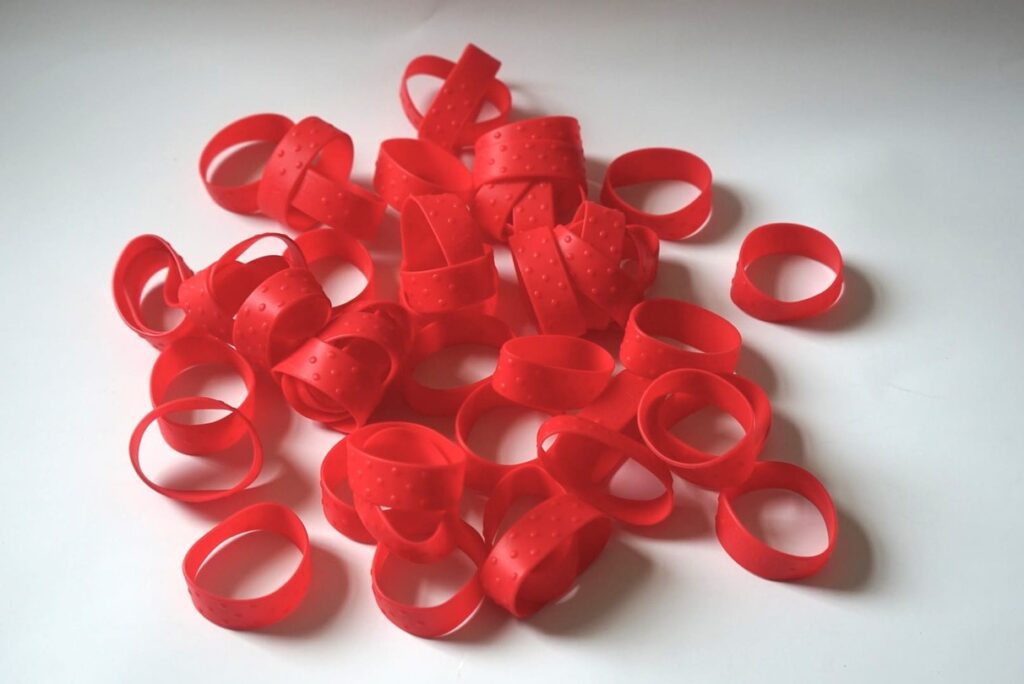Ever wondered what gives rubber bands their stretchiness and durability? The raw material plays a crucial role in determining the quality and performance of rubber bands.
The primary raw materials used for rubber bands are natural rubber (NR) and synthetic rubbers such as Styrene-Butadiene Rubber (SBR), Nitrile Rubber (NBR), and Polyisoprene. These materials are chosen for their excellent elasticity, strength, and ability to return to their original shape after stretching.

Understanding the raw materials used in rubber bands helps manufacturers and consumers choose the best products for their needs. Let’s dive into the details of each material.
What Is Natural Rubber (NR)?
Natural rubber1 is a popular choice for manufacturing rubber bands due to its excellent elasticity and strength.
Natural rubber is derived from the latex of rubber trees (Hevea brasiliensis). It provides superior elasticity, high tensile strength, and resilience, making it ideal for rubber bands that need to stretch and return to their original shape.
Benefits of Natural Rubber
| Feature | Natural Rubber (NR) ✅ |
|---|---|
| Elasticity | Excellent |
| Tensile Strength | High |
| Durability | Good |
| Temperature Resistance | Moderate |
| Applications | Rubber bands, tires, gaskets |
Natural rubber is the preferred choice for high-performance rubber bands due to its superior stretch and recovery characteristics.
What Is Styrene-Butadiene Rubber (SBR)?
Styrene-Butadiene Rubber2 (SBR) is a synthetic rubber used in various applications, including rubber bands.
SBR is made by copolymerizing styrene and butadiene. It offers good abrasion resistance, flexibility, and durability, but it lacks the same level of elasticity as natural rubber. SBR is commonly used when cost-efficiency and reliability are more important than maximum elasticity.
Benefits of SBR
| Feature | Styrene-Butadiene Rubber (SBR) ✅ |
|---|---|
| Elasticity | Moderate |
| Durability | Good |
| Cost | Lower than NR |
| Temperature Resistance | Moderate |
| Applications | Rubber bands, footwear, automotive |
SBR rubber bands are typically more cost-effective but may not perform as well in terms of stretching and returning to shape as natural rubber bands.
What Is Nitrile Rubber (NBR)?
Nitrile Rubber3 (NBR) is another synthetic rubber used in specific types of rubber bands, especially those that need to be resistant to oils and chemicals.
Nitrile rubber is made from the copolymerization of butadiene and acrylonitrile. It offers excellent resistance to oils, fuels, and chemicals, making it a good choice for industrial applications. While NBR rubber bands have lower elasticity compared to NR, they are much more durable and resistant to harsh conditions.
Benefits of NBR
| Feature | NBR Seal ✅ |
|---|---|
| Elasticity | Low to moderate |
| Chemical Resistance4 | Excellent |
| Durability | High |
| Temperature Resistance | Good |
| Applications | Industrial rubber bands, automotive, seals |
NBR rubber bands are ideal for environments exposed to oils, fuels, and chemicals, where standard rubber bands might degrade.
What Is Polyisoprene Rubber?
Polyisoprene is a synthetic rubber that closely mimics the properties of natural rubber.
Polyisoprene rubber is often used as an alternative to natural rubber. It provides similar elasticity, tensile strength, and resilience, making it a suitable choice for applications that require the characteristics of natural rubber without the use of natural resources.
Benefits of Polyisoprene
| Feature | Polyisoprene Rubber5 ✅ |
|---|---|
| Elasticity | Excellent |
| Durability | High |
| Chemical Resistance | Good |
| Cost | Moderate |
| Applications | Rubber bands, medical uses, tires |
Polyisoprene is a good option for those looking for a synthetic alternative to natural rubber with similar performance.
What Gives Rubber Bands Their Strength?
Curious about what makes rubber bands so strong? Their unique elasticity comes from the molecular structure of the raw material used.
The strength of rubber bands comes from the cross-linking of polymer chains during the compounding and vulcanization process. The molecular bonds allow the rubber to stretch and return to its original shape without permanent deformation.
Factors Influencing Rubber Band Strength
| Factor | Impact on Strength |
|---|---|
| Polymer Type | Natural rubber has superior elasticity |
| Vulcanization Process6 | Determines elasticity and durability |
| Additives & Fillers | Improve strength and abrasion resistance |
The vulcanization and cross-linking process are essential for creating strong, durable rubber bands.
What Chemical Is in Rubber Bands?
Wondering about the chemicals in rubber bands? They’re designed for flexibility and durability.
Rubber bands are made from chemicals like sulfur (for vulcanization), antioxidants, and stabilizers, which ensure the rubber maintains its strength, elasticity, and resistance to wear.
Key Chemicals in Rubber Bands
| Chemical Component | Purpose |
|---|---|
| Sulfur | Vulcanizes rubber, increases strength and elasticity |
| Antioxidants | Prevents degradation from oxygen and heat |
| Accelerators | Speeds up the curing process |
These chemicals work together to create a product that is strong, flexible, and long-lasting.
What Are Standard Rubber Bands?
Wondering what defines a "standard" rubber band? It’s based on size, shape, and elasticity.
Standard rubber bands are typically made from natural rubber or a mix of synthetic rubber compounds. They are designed for general-purpose use, such as organizing objects, bundling materials, or sealing bags.
Common Standard Sizes and Applications
| Size (Length) | Width | Applications |
|---|---|---|
| Small (1.5 - 3 cm) | 1 - 2 mm | Office, school, packaging |
| Medium (3 - 5 cm) | 2 - 3 mm | General-purpose, grocery stores |
| Large (5 cm and above) | 3 - 4 mm | Industrial use, bundling larger items |
Standard rubber bands are commonly found in offices, homes, and industrial settings for various general tasks.
What Are the Applications of Rubber Bands?
Rubber bands are used in many everyday and industrial applications. Here are some key uses:
Rubber bands are commonly used for packaging, organizing, sealing, and in industrial applications like automotive seals, medical devices, and more.

Common Uses for Rubber Bands
| Application | Industry or Use Case |
|---|---|
| Office Use | Bundling papers, holding documents |
| Packaging | Securing packages, bag closures |
| Industrial Use | Seals for machinery, automotive parts |
| Medical Use | Surgical instruments, medical tubing |
| Household Use | Organizing items, securing food bags |
Rubber bands are versatile and can be found in almost every industry, fulfilling various functional needs.
Conclusion
The raw materials for rubber bands, such as natural rubber, SBR, NBR, and Polyisoprene, are chosen for their elasticity, strength, and durability. Their performance is enhanced through vulcanization, and chemicals like sulfur and antioxidants are used to improve their longevity. Rubber bands have a wide range of applications across different industries, from office use to industrial machinery.
🚀 Need Custom Rubber Bands for Your Industry?
Contact Julong Rubber today or Request a Custom Quote for high-performance rubber band solutions!
Explore the benefits of natural rubber to understand why it's preferred for high-performance applications like rubber bands. ↩
Learn about Styrene-Butadiene Rubber's applications and advantages in various industries, especially in cost-effective solutions. ↩
Discover the unique properties of Nitrile Rubber and its suitability for industrial applications, especially in harsh environments. ↩
Understanding the chemical resistance of rubber bands can help you choose the right type for your specific needs, especially in industrial applications. ↩
Learning about polyisoprene rubber can help you make informed decisions about synthetic alternatives that offer similar performance to natural rubber. ↩
Exploring the vulcanization process will provide insights into how rubber bands achieve their strength and durability, crucial for various applications. ↩







